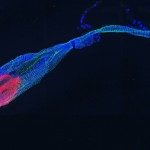Lien vers Pubmed [PMID] – 19708669
J Phys Chem B 2009 Sep;113(38):12796-803
To emphasize the role played by the S-S bridge in the structural features of somatostatin-14 (SST-14), newly recorded CD and Raman spectra of this cyclic peptide and its open analogue obtained by Cys–>Ser substitution are presented. CD spectra of both peptides recorded in aqueous solutions in the 100-500 microM concentration range are strikingly similar. They reveal principally that random conformers constitute the major population in both peptides. Consequently, the S-S bridge has no structuring effect at submillimolar concentrations. In methanol, the CD spectrum of somatostatin-14 keeps globally the same spectral shape as that observed in water, whereas its open analogue presents a major population of helical conformers. Raman spectra recorded as a function of peptide concentration (5-20 mM) and also in the presence of 150 mM NaCl provide valuable conformational information. All Raman spectra present a mixture of random and beta-hairpin structures for both cyclic and open peptides. More importantly, the presence or the absence of the disulfide bridge does not seem to influence considerably different populations of secondary structures within this range of concentrations. CD and Raman data obtained in the submillimolar and millimolar ranges of concentrations, respectively, lead us to accept the idea that SST-14 monomers aggregate upon increasing concentration, thus stabilizing beta-hairpin conformations in solution. However, even at high concentrations, random conformers do not disappear. Raman spectra of SST-14 also reveal a concentration effect on the flexibility of the S-S linkage and consequently on that of its cyclic part. In conclusion, although the disulfide linkage does not seem to markedly influence the SST-14 conformational features in aqueous solutions, its presence seems to be necessary to ensure the flexibility of the cyclic part of this peptide and to maintain its closed structure in lower dielectric constant environments.

